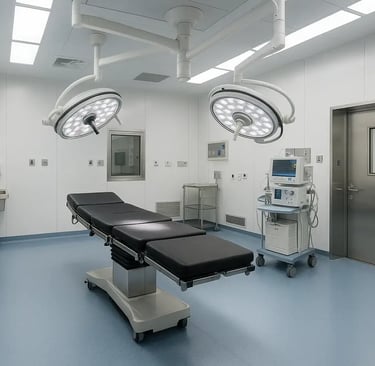How to Design a Modular OT That Meets NABH Standards
Learn how to design a modular Operation Theatre (OT) that aligns with NABH standards. Explore critical design principles, MEP requirements, and infection control strategies for compliant OT construction.
7/11/20252 min read


Introduction: Why Modular OTs Are the Future of Healthcare Design
Operation Theatres (OTs) are the heart of a hospital. A well-designed OT can reduce infection, improve surgical outcomes, and streamline staff efficiency. Today, modular OTs are the preferred choice due to their precision-engineered components, hygiene benefits, and compliance-ready construction.
At Archora, we specialize in turnkey hospital solutions — and that includes NABH-compliant modular OTs that are efficient, future-proof, and tailored for critical care.
1. NABH Guidelines: What Does Compliance Really Mean?
The National Accreditation Board for Hospitals & Healthcare Providers (NABH) mandates clear specifications for:
OT zoning and air pressure gradients
Fire safety
MEP services (HVAC, electrical, medical gas, plumbing)
Surface finishes and cleaning protocols
Key zones include:
Sterile zone: OT room, scrub area
Semi-sterile zone: Pre-op, sterile storage
Non-sterile zone: Dirty utility, corridor, patient holding
2. Modular Construction: Materials That Make a Difference
Modular OTs are made from prefabricated panels and standardized components. This ensures fast installation, low maintenance, and contamination control.
Common materials:
Walls: PUF/EPS insulated panels with anti-bacterial coatings
Flooring: Conductive vinyl or epoxy
Ceiling: Laminar airflow-integrated false ceiling
View panels: Toughened, double-glazed, flush-fitted glass
At Archora, we ensure all materials are anti-fungal, non-porous, and easy to disinfect, in line with NABH norms.
3. MEP Integration: Designing for Clinical Safety
A modular OT is only as good as its engineering backbone. MEP services need seamless coordination with modular structures.
HVAC Design Includes:
Laminar Air Flow (LAF) system
AHU with HEPA filters
Air pressure differentials (positive pressure in OT)
Electrical Considerations:
Backup power systems (UPS + generator)
LED shadowless lighting
Hermetically sealed electrical sockets
Medical Gas Lines:
Oxygen, vacuum, nitrous oxide
Color-coded pipe network with pressure gauges
4. Infection Control: Designing for Sterility
Modular OTs reduce infection by minimizing joints, cracks, and dust traps. But it’s not just about surfaces — it’s about system-wide sterility.
Infection Control Features:
Seamless wall-to-floor coving
Rounded corners and coved skirting
Pass boxes for instrument transfer
Hermetically sealed doors
Copper ion-infused surfaces (optional)
Our turnkey OTs are designed in consultation with infection control officers and surgeons to ensure real-world functionality.
5. Technology Integration: Building Smart OTs
Today’s OTs demand tech integration. We provide smart modular OTs equipped with:
Touchless sensor lighting and doors
Integrated OT control panels
CCTV and telemedicine support
PACS compatibility for digital imaging
Conclusion: Turnkey Compliance with Design Precision
At Archora, we don’t just design OTs — we deliver NABH-ready, infection-proof, performance-driven modular operation theatres. Whether you’re upgrading a facility or building a new hospital, our team ensures regulatory alignment with architectural excellence.
Need help designing a modular OT? Contact Archora for expert consultation.

ARCHORA
Where Infrastructure Inspires Healing
Innovate
Inspire
© 2025. All rights reserved.
Create
